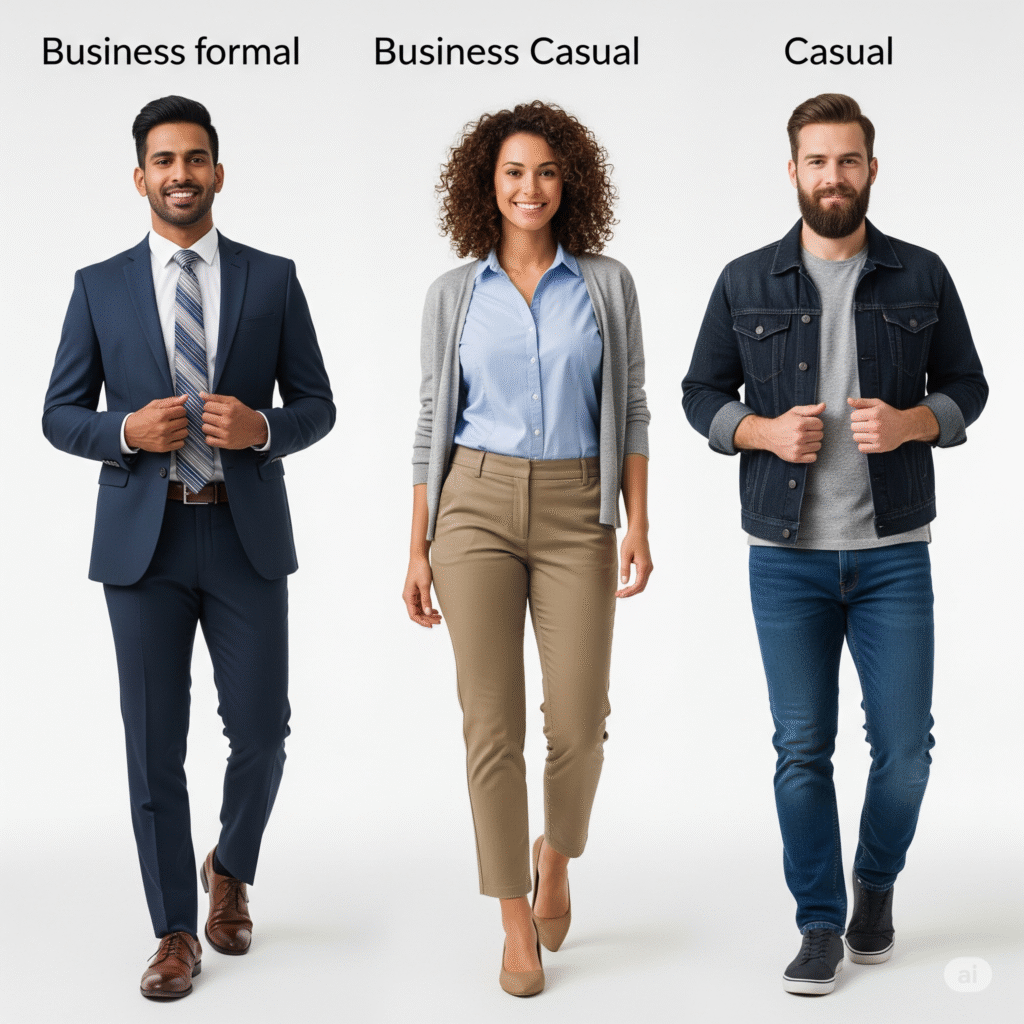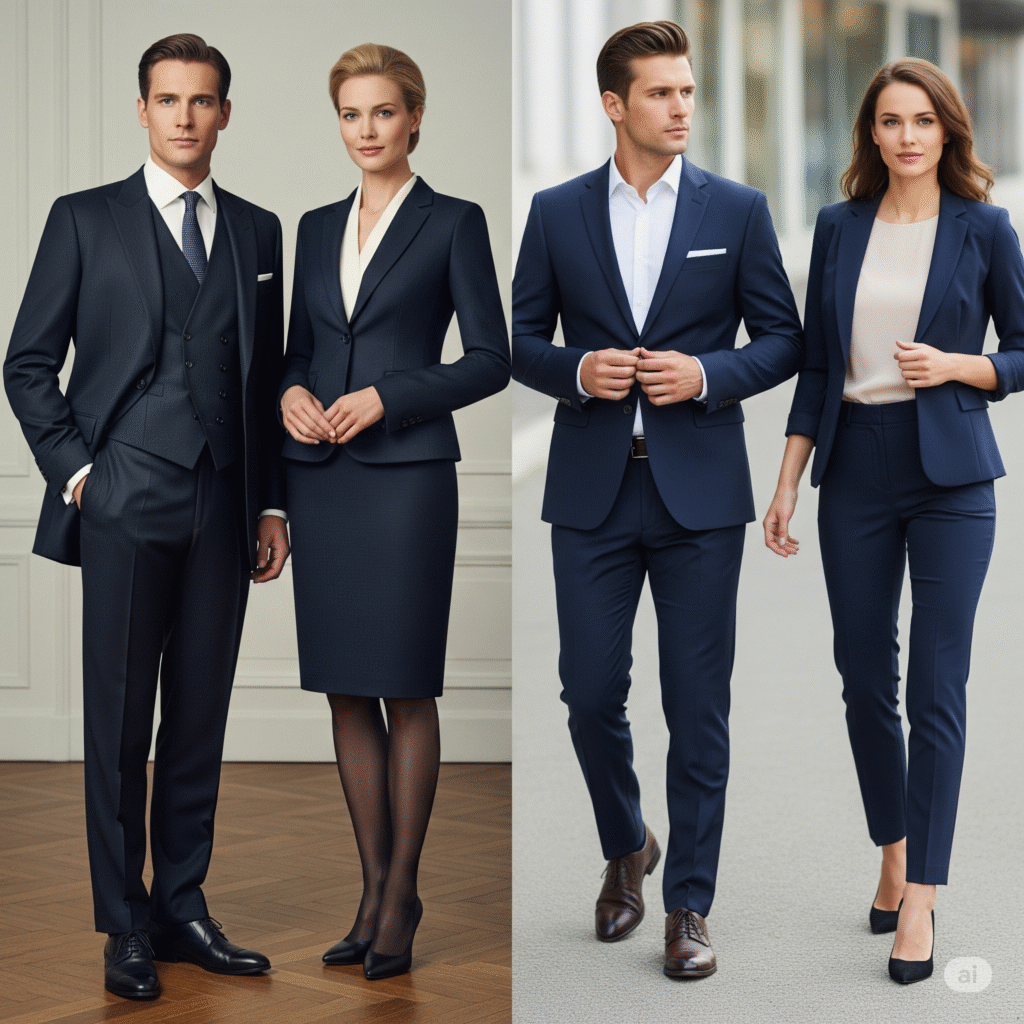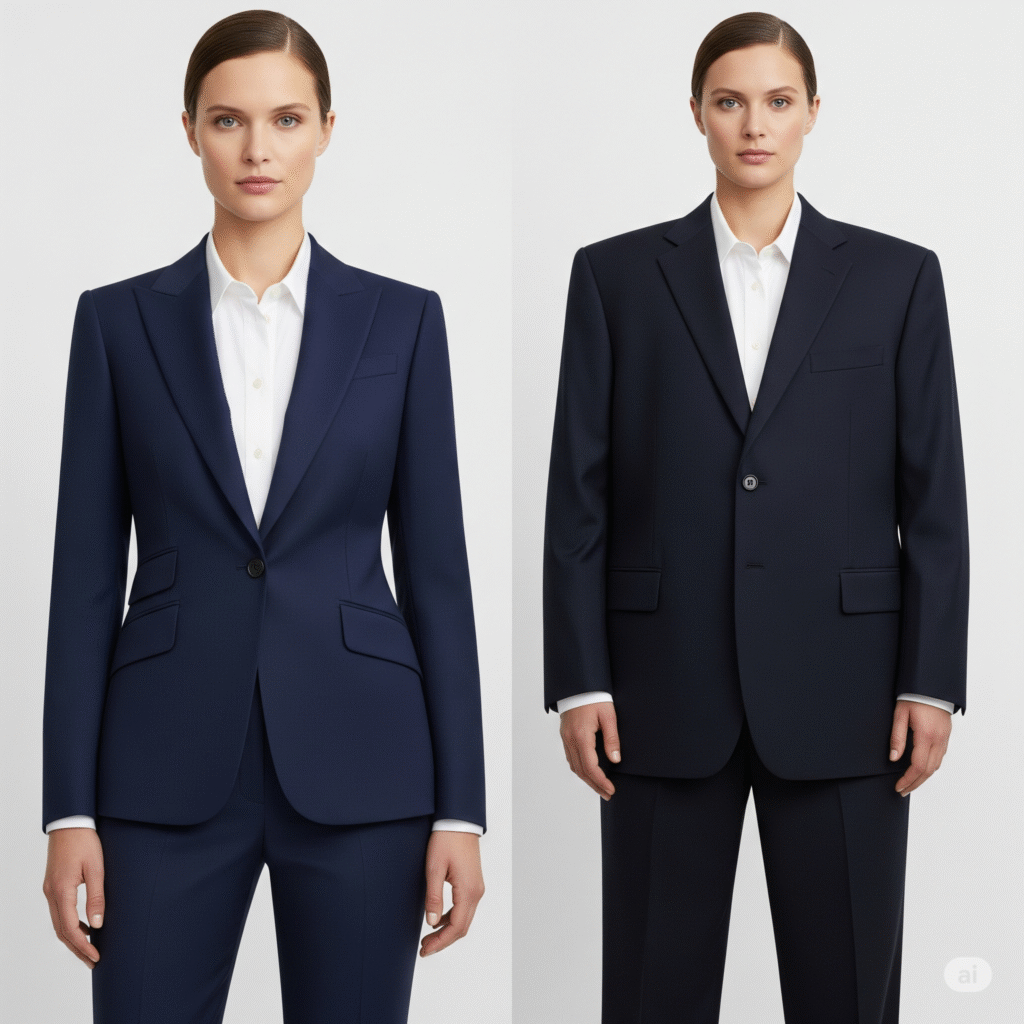
Here is guide for Office dressing tips because Professional attire speaks volumes before you say a single word in the workplace. Despite dress codes becoming more relaxed in many industries, the unwritten rules of workplace fashion continue to influence how colleagues and superiors perceive your competence and professionalism.
The challenge lies not in following a written dress code, but in deciphering the subtle expectations that your boss assumes you already understand. Office Dressing Tips often focus on basic guidelines while overlooking these crucial nuances. What exactly constitutes “business casual”? When is your outfit too casual for “casual Friday”? These questions rarely receive clear answers.
This guide will decode the unspoken rules of workplace fashion that can impact your career trajectory. From understanding different levels of professional dress to avoiding common mistakes that silently damage your reputation, we’ll provide the clarity your employee handbook never did.
We have plenty of office dressing tips to help you decide what to wear and what to avoid at work
To enhance your look you have to add some accessories if you want to know what so there is a guide Best Accessories Wear with Jeans by which you can look elegant .
The Real Purpose Behind Dress Codes

Dress codes have evolved dramatically since the late 20th century, shifting from the rigid formality of suits and ties to today’s varied standards across industries. However, these policies serve deeper purposes than simply maintaining appearances. They silently communicate company values, establish workplace psychology, and shape professional identities in ways that extend far beyond what’s written in the employee handbook.
Why dress codes exist beyond the rulebook
The formal dress code was once universally accepted as a symbol of professionalism and respect 1. Today, companies implement dress guidelines for several strategic reasons that often go unspoken:
Brand identity reinforcement – Your attire reflects not just your personal style but the company’s culture and values. Consistent professional dress helps maintain brand identity and strengthens recognition both internally and externally 2. This is particularly important in client-facing roles, where employee appearance directly influences perceptions of company credibility and trustworthiness.
Psychological transition – What you wear creates a mental shift. According to research on “enclothed cognition,” professional clothing influences cognitive processes and can enhance work performance 3. Essentially, dressing the part helps employees transition into a work-oriented mindset, allowing them to focus more on tasks and responsibilities.
Cultural cohesion – In organizations where teamwork is a core value, standardized dress codes reduce status differences and reinforce unity. For example, Toyota Corporation requires all employees to wear polo shirts and khakis specifically to express their team-oriented culture 1.
Productivity maintenance – Although casual dress is often promoted for comfort, studies show unexpected consequences. According to a survey of human resource executives, almost half of companies with casual dress-down policies reported significant increases in tardiness, absenteeism, and flirtatious behavior 1. Additionally, another survey concluded that casual dress may lead to a casual work ethic 1.
How attire shapes perception in the workplace

Your clothing choices create powerful impressions that affect both how others see you and how you see yourself:
External perception – First impressions form within seconds, with appearance heavily influencing initial judgments 4. When meeting someone for the first time, our brains make snap judgments that are significantly affected by attire. Consequently, wearing professional business attire can convey competence, reliability, and respect for the environment.
Authority and advancement – Formal business attire is strongly linked to career progression. In one survey, 70% of executives said they perceive employees dressed in suits to be more senior level, while 60% said those in suits are taken more seriously 1. Notably, people adopting formal attire believed they could influence others’ views, achieve greater power, and attain work-related outcomes such as advancement or compensation increases 1.
Cognitive performance – The impact of professional attire extends beyond appearances. Research shows individuals wearing formal business attire were more likely to engage in abstract thinking, a cognitive process linked to creativity and problem-solving 5. This demonstrates that clothing affects not just how we’re perceived, but how we actually perform.
The psychological impact of dressing professionally creates a feedback loop: when you feel confident in your appearance, it enhances self-esteem, improves interpersonal interactions, and boosts overall workplace well-being 6. For this reason, understanding the deeper purpose of dress codes becomes essential for professional success, regardless of your industry’s specific standards .if you follow our office dressing tips so you have achieve this things .
Types of Professional Attire You’re Expected to Know

Understanding the spectrum of professional attire options goes beyond simply knowing what to wear—it’s about grasping the subtle distinctions between seemingly similar dress codes. Most employers won’t spell it out, but they expect you to decode these expectations on your own. That’s where the right office dressing tips become essential. With thoughtful office dressing tips tailored to different industries and company cultures, you can present yourself with confidence and clarity.
Business formal vs. business professional

Business formal represents the highest level of professional dress, primarily reserved for executive-level positions, formal events, and conservative industries like law, finance, and government. If you’re navigating a new workplace or stepping into a leadership role, understanding this distinction is one of the most essential office dressing tips to keep in mind.
For men, this means dark suits (typically black, charcoal, or navy) with matching vests, crisp white dress shirts, conservative ties, and polished leather dress shoes. Women should opt for tailored pantsuits or skirt suits in dark colors, closed-toe heels under 3 inches, minimal jewelry, and neutral hosiery. Among the most reliable office dressing tips is to prioritize timeless, structured pieces that communicate confidence and professionalism.
Business professional, meanwhile, offers slightly more flexibility while maintaining formality. Men can incorporate subtle patterns and wider color options (including lighter grays and blues) in their suits, with more variety in shirt colors. Women can choose separates rather than matching suits—such as a blazer with coordinating skirt or pants—and introduce modest patterns and colors. One of the most practical office dressing tips for this category is to balance personality with polish—clean lines and professional silhouettes, but with room for individual flair.
The key distinction: business formal prioritizes tradition and conservatism, whereas business professional allows tasteful personal expression within clearly defined boundaries.
Business casual vs. smart casual
The term “business casual” creates more confusion than perhaps any other dress code. This middle-ground standard typically means no jeans, t-shirts, or sneakers, yet doesn’t require full suits.
For men, business casual generally includes:
- Dress slacks or khakis
- Button-down shirts (with or without ties)
- Sport coats or blazers (optional depending on the setting)
- Leather shoes (loafers, oxfords, or brogues)
For women, business casual encompasses:
- Tailored pants or knee-length skirts
- Blouses, button-downs, or modest tops
- Cardigans or blazers
- Closed-toe shoes (flats, low heels, or loafers)
Smart casual, in contrast, sits between business casual and casual attire, allowing for more relaxed yet still polished elements. This might include dark, well-fitted jeans paired with blazers, more creative accessories, and occasionally even tasteful sneakers in creative industries. The emphasis remains on “smart”—everything should look intentional and put-together rather than thrown on.
When casual is too casual
Even in workplaces with relaxed dress codes, certain items typically remain inappropriate. Understanding these boundaries prevents uncomfortable feedback from management.
Generally unacceptable items include:
- Anything with obvious stains, holes, or excessive wear
- Flip-flops, athletic slides, or beachwear
- Revealing clothing (low-cut tops, visible undergarments, very short skirts/shorts)
- Graphic tees with potentially offensive content
- Athletic wear outside of fitness-related roles
- Overly wrinkled or ill-fitting garments
Furthermore, “casual Friday” policies don’t translate to “weekend casual.” While jeans might be acceptable, pairing them with polished tops and proper footwear maintains professionalism. Remember that many companies have implemented stricter dress codes after casual policies led to inappropriate choices.
The most reliable approach: observe what successful leaders in your organization wear, particularly those in positions you aspire to reach. Their attire choices likely represent unspoken expectations far more accurately than any written policy.
The Unspoken Rules Your Boss Assumes You Know
Beyond the basic dress code rules lies a subtle world of professional attire expectations that bosses rarely articulate. These unspoken standards often influence workplace perception more profoundly than written policies. Let’s decode these silent rules that can significantly impact your professional image.
Fit matters more than brand

The quality of your clothing’s fit trumps designer labels every time. When clothing fits properly, it signals attention to detail and creates a polished professional image. Indeed, research suggests that well-fitted attire boosts confidence and enhances workplace performance. Properly tailored clothing allows for comfortable movement while maintaining a sharp appearance that commands respect.
“Have your clothes tailored to fit your body,” advises many style experts. Loose clothing creates an unprofessional, sloppy impression, whereas items that are too tight appear inappropriate for office settings. First, invest in quality basics that suit your body type, then find a reliable tailor who can customize off-the-rack items to your proportions. Remember that clothing conforming to your body’s shape, allowing space to breathe while avoiding bulk, makes the most significant difference in your appearance.
Neutral colors are safer bets
Color psychology plays a crucial role in workplace perception. Neutral colors like black, navy, gray, and charcoal exude professionalism and sophistication while offering maximum versatility. These shades are particularly valued in conservative industries such as finance, law, and government.
For formal work environments, consider these neutral color options:
- Deep navy or charcoal for suits and blazers
- White, light blue, or pale pink for shirts and blouses
- Beige or taupe as softer alternatives to black
- Gray in various shades for versatile pairing
In more creative fields, you might introduce controlled amounts of color, but neutral foundations provide the safest foundation for professional attire. Accordingly, many successful professionals build wardrobes around neutral core pieces, adding personality through subtle accessories or accent colors.
Avoid over-accessorizing
Regarding workplace accessories, the “less is more” approach prevails. Excessive jewelry, particularly items that make noise or movement, can distract colleagues and undermine your professional presence. Simple, classic accessories enhance your look without overpowering it.
For professional settings, limit yourself to a few quality pieces: a tasteful watch, simple earrings, perhaps a single bracelet or necklace. Moreover, functional accessories like leather belts and structured bags in neutral colors elevate your appearance while serving practical purposes. The objective is complementing your outfit rather than having accessories become the focal point of your professional image.
Shoes are noticed more than you think
Footwear often receives more attention than many realize. In professional settings, clean, polished shoes complete your overall look and demonstrate attention to detail. Quality shoes are frequently associated with success and professionalism, sending subtle yet powerful messages about your standards.
Closed-toe options in leather with modest heels (for women) or polished leather shoes (for men) remain the safest choices. Additionally, comfortable yet professional footwear affects your posture, confidence, and productivity throughout the workday. Your boss likely notices your shoe choices more than you imagine—worn heels, scuffed leather, or inappropriate casual styles can undermine an otherwise professional appearance.
Grooming is part of the outfit
Personal grooming completes your professional presentation. Even the most expensive clothing cannot compensate for poor grooming habits. This includes neat hair, trimmed nails, subtle fragrance, and overall cleanliness. Furthermore, personal grooming shows respect for yourself and those around you.
For workplace settings, maintain conservative hairstyles, clean and trimmed fingernails, and minimal, appropriate makeup. Similarly, use fragrances sparingly—your scent should not linger after you leave. These grooming standards aren’t merely about esthetics; they demonstrate your understanding of professional environments and attention to detail that likely transfers to your work quality.
Situational Office Dressing Tips : What No One Tells You
Mastering the art of situational dressing requires understanding how to adapt your professional attire beyond basic dress codes. Successful professionals recognize that different contexts demand specific wardrobe choices to create the right impression and build trust.
Dressing for client meetings vs. internal days

According to the Wall Street Journal, failing to master situational dressing could be costing companies deals 7. Dressing too formally in certain settings can signal an unwillingness to adapt, while appearing too casual when clients expect formality may mark you as not serious enough. For client interactions, always dress slightly more formally than your everyday office wear.
For presentations and client meetings, prioritize polished, conservative choices—a three-piece suit in a clean solid or elegant pinstripe works perfectly. One of the key office dressing tips in such settings is to project confidence and professionalism through structured, classic pieces. Alternately, for internal days, you might adopt a more relaxed yet still professional approach with a sport coat and dress pants combination that maintains a clean image without seeming overly formal. These subtle shifts in attire are valuable office dressing tips for navigating different workplace scenarios. By understanding when to scale your look up or down, you’ll be applying some of the most practical office dressing tips for modern professionals.
Remote work doesn’t mean pajama day
Though working from home offers flexibility, maintaining professional standards remains essential. Studies indicate professionals who dress formally for remote work often feel more productive and effectively execute daily tasks 9. Establishing a pre-work routine that includes changing out of sleepwear creates a clear mental boundary between personal and professional time.
For video calls, focus on your “top half” with professional button-downs, blouses, or structured knitwear 10. Nevertheless, wear complete outfits—you never know when you might need to stand during a conference . Remember that telecommuting is not a day off; observe regular working hours and minimize distractions 11.
Casual Fridays still have limits
Even on dress-down days, certain boundaries must be respected. Casual Fridays offer a break from formal dress codes but don’t signal complete freedom . Organizations with client-facing roles often maintain stricter casual Friday guidelines to preserve public reputation .
Inappropriate choices include flip-flops, sweats, pajamas, sleeveless t-shirts, or clothing with tasteless messages . Furthermore, avoid experimenting with trendy styles like acid-washed jeans, regardless of their price tag . Always consider climate appropriateness and generational differences in dress standards when interpreting casual Friday guidelines
Common Mistakes That Go Uncorrected
Even seasoned professionals make wardrobe missteps that silently damage their workplace reputation. These common fashion errors often go uncorrected because supervisors hesitate to give direct feedback about personal appearance.
Wearing wrinkled or stained clothes
Nothing undermines your professional image faster than wrinkled or stained clothing. Wrinkled attire sends a non-verbal message that you’re unbothered, lazy, or simply lack class. This seemingly minor detail creates an impression of overall carelessness that might transfer to perceptions of your work quality.
The solution is straightforward: prepare your business attire the night before important meetings or workdays. This allows time for proper ironing and inspection. Consider investing in wrinkle-resistant fabrics or keeping a portable steamer at the office for midday touch-ups.
Ignoring company culture cues
Every workplace has unwritten rules about appropriate attire that extend beyond formal policies. Watch how successful leaders dress—their choices likely represent the unspoken expectations. Fitting into your company’s culture doesn’t mean abandoning personal style but adapting it appropriately.
Pay attention to how colleagues react to your outfits. If senior team members consistently dress more formally than you, consider elevating your wardrobe accordingly. Remember that ill-fitting clothing ranks among the most common professional attire mistakes, so proper tailoring remains essential.
Overlooking seasonal appropriateness
Wearing clothing unsuitable for the current season creates an oddly disconnected impression. This often happens when professionals have limited professional wardrobes and wear what they have regardless of weather conditions.
In northeastern regions, for instance, wearing sleeveless tops without jackets during winter appears strangely out of place. Seasonal appropriateness signals awareness of your surroundings and attention to context—qualities valued in professional settings.
Misjudging the line between trendy and tacky
Incorporating current fashion trends into professional attire requires careful judgment. Certain colors work better with specific skin tones, and not all trendy items translate well to office settings.
Neutral colors dominate traditional business attire for good reason—they project seriousness and professionalism. Thus, while personal expression has value, experiment cautiously with bold colors or patterns, especially in conservative industries.
it loos outstanding with kurti also so if have to try here we a guide for you Stylish Modern Kurti With Jeans so you can find which looks better on you .
Conclusion
The unspoken rules of professional attire might seem complex, yet mastering them remains essential for career advancement. Throughout this guide, we’ve decoded the subtle expectations your boss assumes you understand, offering actionable office dressing tips along the way. Certainly, dress codes serve deeper purposes than mere appearances—they reinforce brand identity, create psychological transitions, and maintain productivity standards.
Understanding various attire categories provides clarity where employee handbooks fall short. The difference between business formal and business professional, or business casual versus smart casual, can significantly impact workplace perception. That’s why targeted office dressing tips can be a game-changer in helping you navigate each category with confidence and accuracy. Additionally, recognizing when casual crosses into inappropriate territory protects your professional reputation—another area where well-informed office dressing tips are invaluable.
Quality and fit matter far more than designer labels. Well-tailored clothing signals attention to detail, while neutral colors offer versatility across professional settings. Among the most important office dressing tips is to invest in staples that can be mixed and matched without compromising professionalism. Most importantly, shoes and grooming complete your image in ways many overlook—core elements in any list of effective office dressing tips.
Situational dressing requires adapting your wardrobe to specific contexts. Client meetings demand more formality than internal days, while remote work still calls for professional standards. Casual Fridays provide flexibility within clear boundaries that successful professionals never cross. Smart office dressing tips help you strike that balance effortlessly.
Avoiding common mistakes—wrinkled clothing, cultural misalignment, seasonal inappropriateness, or fashion misjudgments—prevents silent damage to your workplace standing. These issues often go uncorrected by supervisors, yet thoughtful office dressing tips can help you spot and fix them yourself before they harm your image.
Professional attire speaks volumes before you say a word. The thoughtful application of these unspoken rules—grounded in practical office dressing tips—demonstrates not just fashion sense but workplace awareness and professional judgment. Your clothing choices reflect your attention to detail, respect for company culture, and readiness for advancement—making these subtle standards worth every bit of your attention.
References
[1] – https://central.edu/writing-anthology/2019/06/04/dress-codes-in-the-workplace-effects-on-organizational-culture/
[2] – https://gsiassociates.com/the-importance-of-workplace-dress-code/
[3] – https://www.powersutra.co/blogs/news/importance-of-dress-code-in-professional-life?srsltid=AfmBOoqfW5x53cn3iA7qQ5bryUyNDmrou_AhH0xTE0H1bTjXNklz_CIa
[4] – https://www.linkedin.com/pulse/impact-attire-workplace-analytical-view-webhr-irjve
[5] – https://onfra.io/blogs/dress-code-impact-on-workplace-productivity-fact-or-fiction/
[6] – https://www.corporatewellnessmagazine.com/article/dressing-for-success-unveiling-the-psychological-benefits-for-employee-well-being
[7] – https://styleliberation.co.uk/are-you-ready-for-situational-dressing/
[8] – https://www.linkedin.com/pulse/what-wear-office-situational-dressing-tips-janine-giorgenti
[9] – https://www.indeed.com/career-advice/career-development/work-from-home-dress-code
[10] – https://www.powersutra.co/blogs/news/virtual-meeting-dressing-for-women-remote-work-fashion?srsltid=AfmBOooOU-doVXEcCdKMCyOVRK7gbHBUVsMcVIYRBjg_YThsPiNW2syf
[11] – https://gethppy.com/company-culture/casual-fridays-dos-donts
[12] – https://www.workspace.co.uk/content-hub/business-insight/guide-to-dress-down-fridays-and-casual-fridays
[13] – https://www.vantagecircle.com/en/blog/casual-friday-at-work/
